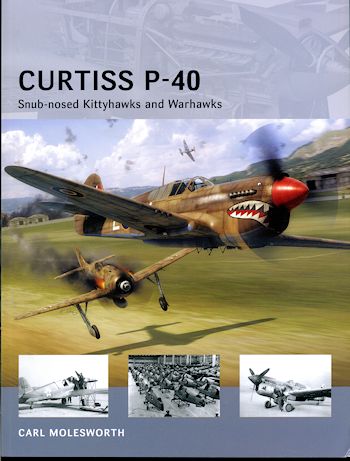 One of
the few planes that fought from the first day of America's involvement in WWII
until the last was the Curtiss P-40. Built in a number of variants, the earlier
planes with the shallower lower nose intake were the Tomahawk while the later
versions with the deeper coolant intake were called either Kittyhawk (mostly by
Commonwealth forces) or the Warhawk.
One of
the few planes that fought from the first day of America's involvement in WWII
until the last was the Curtiss P-40. Built in a number of variants, the earlier
planes with the shallower lower nose intake were the Tomahawk while the later
versions with the deeper coolant intake were called either Kittyhawk (mostly by
Commonwealth forces) or the Warhawk.
While the aircraft was nearing obsolescence when it was first put into
battle, the fact is that it was the most numerous USAAC/F fighter of the war.
Its plusses were a rugged airframe that could sustain a lot of damage, a
relatively powerful offensive armament of either four or six .50 machine guns,
and an aircraft that was easily adapted to ground attack.
Most of America's Army fighter pilots flew the P-40 either during
training or in combat; mostly in the south west Pacific and CBI. Here, the
opponent was not considered to be as formidable as the Luftwaffe was in Europe,
though the P-40 flew in Commonwealth hands during the North Africa and
Mediterranean campaigns as well as with some US units until replaced by either
Mustangs or Thunderbolts, some having to wait until very late in the war to put
their P-40s to pasture.
In this book by Carl Molesworth, we look at the changes that occurred to
the airframe after the P-40C. The D model, which was built in small numbers and
was virtually indistinguishable to the P-40E was first followed by the more
widely built E model. It is this version that saw most of the early fighting.
Attempts at installing a Packard built Merlin engine to provide better high
altitude performance resulted in the F model and later the L version. This did
not provide as great a performance improvement as was hoped and all other
versions returned to the Allison engine. Late Es and the K model for the most
part had a broader fin to try to cure horizontal instability that was present in
most versions. Even extending the fuselage and rudder back many inches did not
completely get rid of this trait.
As it is with all aircraft, these improvements were incorporated in the
production line and did not always result in a new designation. The N was the
last version to be built and incorporated a new rear canopy section that got rid
of the scallops along the side. It was also initially a lighter weight aircraft
going from six to four guns, but most units replaced the missing guns,
preferring the greater firepower over improved performance. Other versions of
the P-40 did not reach production and this was the last Curtiss fighter to be
mass produced.
In addition to the aircraft itself, the author includes extensive tables
of stats for each of the differences in airframe. This section alone takes up a
third of the book. The last third is a brief history of the type in combat with
different units and in different theaters of operation. This is all accompanied
by some superb art work and a great choice of period photos. It all makes for a
worthwhile book for any P-40 fan and those who just like WWII fighters.
December 2013
For more on the complete line of Osprey books,
visit www.ospreypublishing.com. In the US, it is
Osprey Direct at 44-02 23rd St, Suite 219, Long Island City, NY 11101., where you can
get a catalogue of available books.
If you would like your product reviewed fairly and
fairly quickly, please
contact
the editor or see other details in the
Note to
Contributors.
 One of
the few planes that fought from the first day of America's involvement in WWII
until the last was the Curtiss P-40. Built in a number of variants, the earlier
planes with the shallower lower nose intake were the Tomahawk while the later
versions with the deeper coolant intake were called either Kittyhawk (mostly by
Commonwealth forces) or the Warhawk.
One of
the few planes that fought from the first day of America's involvement in WWII
until the last was the Curtiss P-40. Built in a number of variants, the earlier
planes with the shallower lower nose intake were the Tomahawk while the later
versions with the deeper coolant intake were called either Kittyhawk (mostly by
Commonwealth forces) or the Warhawk.